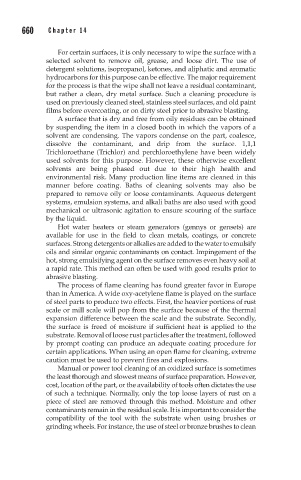Page 706 - Corrosion Engineering Principles and Practice
P. 706
660 C h a p t e r 1 4 P r o t e c t i v e C o a t i n g s 661
For certain surfaces, it is only necessary to wipe the surface with a
selected solvent to remove oil, grease, and loose dirt. The use of
detergent solutions, isopropanol, ketones, and aliphatic and aromatic
hydrocarbons for this purpose can be effective. The major requirement
for the process is that the wipe shall not leave a residual contaminant,
but rather a clean, dry metal surface. Such a cleaning procedure is
used on previously cleaned steel, stainless steel surfaces, and old paint
films before overcoating, or on dirty steel prior to abrasive blasting.
A surface that is dry and free from oily residues can be obtained
by suspending the item in a closed booth in which the vapors of a
solvent are condensing. The vapors condense on the part, coalesce,
dissolve the contaminant, and drip from the surface. 1,1,1
Trichloroethane (Trichlor) and perchloroethylene have been widely
used solvents for this purpose. However, these otherwise excellent
solvents are being phased out due to their high health and
environmental risk. Many production line items are cleaned in this
manner before coating. Baths of cleaning solvents may also be
prepared to remove oily or loose contaminants. Aqueous detergent
systems, emulsion systems, and alkali baths are also used with good
mechanical or ultrasonic agitation to ensure scouring of the surface
by the liquid.
Hot water heaters or steam generators (gennys or gensets) are
available for use in the field to clean metals, coatings, or concrete
surfaces. Strong detergents or alkalies are added to the water to emulsify
oils and similar organic contaminants on contact. Impingement of the
hot, strong emulsifying agent on the surface removes even heavy soil at
a rapid rate. This method can often be used with good results prior to
abrasive blasting.
The process of flame cleaning has found greater favor in Europe
than in America. A wide oxy-acetylene flame is played on the surface
of steel parts to produce two effects. First, the heavier portions of rust
scale or mill scale will pop from the surface because of the thermal
expansion difference between the scale and the substrate. Secondly,
the surface is freed of moisture if sufficient heat is applied to the
substrate. Removal of loose rust particles after the treatment, followed
by prompt coating can produce an adequate coating procedure for
certain applications. When using an open flame for cleaning, extreme
caution must be used to prevent fires and explosions.
Manual or power tool cleaning of an oxidized surface is sometimes
the least thorough and slowest means of surface preparation. However,
cost, location of the part, or the availability of tools often dictates the use
of such a technique. Normally, only the top loose layers of rust on a
piece of steel are removed through this method. Moisture and other
contaminants remain in the residual scale. It is important to consider the
compatibility of the tool with the substrate when using brushes or
grinding wheels. For instance, the use of steel or bronze brushes to clean

